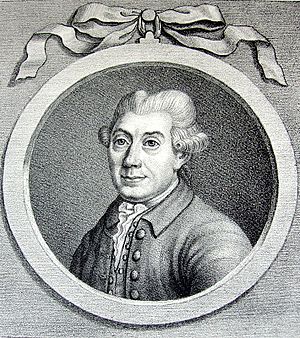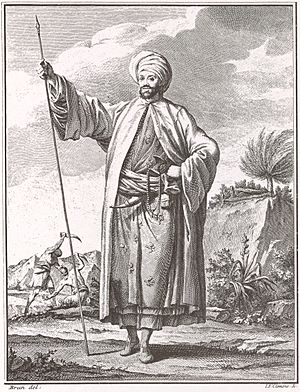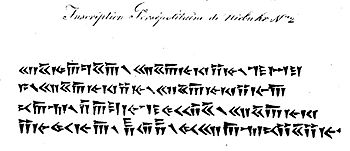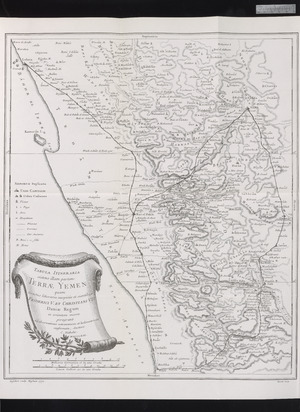Carsten Niebuhr facts for kids
Quick facts for kids
Carsten Niebuhr
|
|
|---|---|
 |
|
| Born | 17 March 1733 Lüdingworth, Bremen-Verden
|
| Died | 26 April 1815 (aged 82) Meldorf, Dithmarschen
|
| Nationality | German |
| Occupation | mathematician, cartographer, and explorer |
| Known for | Royal Danish Arabia Expedition (1761-1767) |
Carsten Niebuhr (born March 17, 1733, died April 26, 1815) was a German mathematician, mapmaker, and explorer. He worked for Denmark and became famous for joining the Royal Danish Arabia Expedition from 1761 to 1767. His son, Barthold Georg Niebuhr, was a well-known historian who wrote about his father's life.
Contents
Early Life and Education
Carsten Niebuhr was born in Lüdingworth, which is now part of Cuxhaven, Germany. His father, Barthold Niebuhr, was a successful farmer. Carsten and his sister were taught at home by a local teacher. Later, Carsten went to a Latin school in Otterndorf.
Niebuhr first wanted to become a surveyor, someone who measures land. But in 1757, he went to the University of Göttingen. This was a very advanced university in Germany at the time.
In 1760, one of his professors, Johann David Michaelis, suggested Niebuhr join a big trip. This trip was the Royal Danish Arabia Expedition. It was organized by Frederick V of Denmark. For about a year and a half before the trip, Niebuhr studied mathematics, mapmaking, and how to navigate using stars. He learned from Tobias Mayer, a famous astronomer. Niebuhr's notes from the expedition later proved that Mayer's method for finding a ship's location at sea was very accurate.
Adventures on the Danish Arabia Expedition
The expedition started in January 1761. They sailed through Marseilles and Malta to Istanbul and Alexandria. Then, the group visited Cairo and the Sinai Peninsula. After that, they crossed the Red Sea to Yemen, which was their main goal.
In Mocha, on May 25, 1763, the expedition's language expert, Frederik Christian von Haven, passed away. On July 11, 1763, on the way to Sanaʽa, the capital of Yemen, the group's nature expert, Peter Forsskål, also died.
In Sanaʽa, the remaining members met with the Imam of Yemen, al-Mahdi Abbas. However, they struggled with the climate and returned to Mocha. Niebuhr was able to stay healthy by wearing local clothes and eating local food.
From Mocha, the expedition continued to Bombay. Sadly, the expedition's artist, Georg Wilhelm Baurenfeind, died on August 29. The servant, Lars Berggren, died the next day. Both were buried at sea. The surgeon, Christian C. Kramer, also died soon after arriving in Bombay. Niebuhr was the only one left from the original group.
He stayed in Bombay for 14 months. Then he traveled back home through places like Muscat, Bushire, Shiraz, and Persepolis. At Persepolis, he copied ancient writings called cuneiform. His copies were very important. They helped experts later understand and read cuneiform writing. This led to the start of a new field of study called Assyriology.
Here are some of the cuneiform copies Niebuhr made:
Niebuhr also visited the ancient ruins of Babylon and made many important drawings. He saw Baghdad, Mosul, and Aleppo. He also visited the Behistun Inscription around 1764. After visiting Cyprus, he traveled through Palestine. He crossed the Taurus Mountains to Bursa, reached Constantinople in February 1767, and finally arrived back in Copenhagen in November of that year.
Niebuhr created many amazing things during his journey. He made detailed maps of Yemen, the Red Sea, the Persian Gulf, and Oman. He also drew larger maps of the Nile Delta, the Gulf of Suez, and areas around port cities he visited, like Mocha and Surat. He drew 28 town plans, which are very valuable because they are unique for that time.
Overall, Niebuhr's maps and plans were the biggest improvement to the maps of that region in the 1700s. He created them by exploring the areas himself.
Family and Later Life
In 1773, Niebuhr married Christiane Sophia Blumenberg. For some years, he worked for the Danish military in Copenhagen. In 1776, he became a foreign member of the Royal Swedish Academy of Sciences.
In 1778, he took a job in the government of Danish Holstein and moved to Meldorf. In 1806, he received a special title, Etatsrat. In 1809, he was made a Knight of the Order of the Dannebrog. This is one of Denmark's most important honors for public service.
Writing and Research
Niebuhr's first book, Beschreibung von Arabien (Description of Arabia), was published in Copenhagen in 1772. The Danish government helped pay for the many pictures in the book. He then published the first two volumes of his Reisebeschreibung nach Arabien und andern umliegender Ländern (Travel Description to Arabia and Other Surrounding Countries) in 1774 and 1778.
These books, especially the one from 1778, were very important for understanding cuneiform writing. Before Niebuhr's book, people often thought cuneiform writings were just decorations. No one had been able to read or translate them accurately. Niebuhr showed that the three different writings he found at Persepolis were actually three separate forms of cuneiform. He called them Class I, Class II, and Class III. He also showed they should be read from left to right. His exact copies of these writings gave experts the key to finally crack the cuneiform code. This led to the discovery of ancient languages like Old Persian, Akkadian, and Sumerian.
The third volume of his travel book was published much later, in 1837, after Niebuhr had passed away. His daughter and assistant helped put it together. Niebuhr also wrote articles for a German magazine called Deutsches Museum. These articles were about places like Africa and the Ottoman Empire. He also edited and published the work of his friend Peter Forsskål, the nature expert from the Arabian expedition.
Translations of Niebuhr's stories were published in French and Dutch during his lifetime. A shorter English version of his three volumes was published in 1792.
The government only paid a small part of the printing costs for Niebuhr's first book. He had to pay more than 80% of the costs himself for all his books. Niebuhr spent ten years, from 1768 to 1778, publishing six volumes of what he found on the expedition. He got almost no help from the professors who had planned the trip. It was only Niebuhr's strong will to share his findings that made sure the Danish Arabia Expedition helped the world of knowledge.
Death and Legacy
Carsten Niebuhr died in Meldorf in 1815.
The famous German writer Johann Wolfgang von Goethe greatly admired Niebuhr's work. In 1811, he wrote to Niebuhr's son, Barthold Georg Niebuhr, saying that he had learned to respect the Niebuhr name since he was young.
A street in the port area of Copenhagen is named Carsten Niebuhrs Gade, in his honor.
In 2011, Copenhagen’s National Library and National Museum held special exhibits about Carsten Niebuhr. They celebrated the 250th anniversary of the Danish Arabia Expedition. Special postal stamps were also made to remember him.
Works
- Niebuhr, Carsten. Beschreibung von Arabien. Aus eigenen Beobachtungen und im Lande selbst gesammleten Nachrichten. Copenhagen, 1772.
- Niebuhr, Carsten. Reisebeschreibung nach Arabien und andern umliegender Ländern. 2 vols. Copenhagen, 1774-1778.
- Niebuhr, Carsten. "Über Längen-Beobachtungen im Orient u.s.w. Aus einem Schreiben des königl. Dänischen geheimer Justiz-Raths Carsten Niebuhr". Monatliche Correspondenz zur Beförderung der Erd- und Himmels-Kunde 4 (1801), pp. 240–253.
- Niebuhr, Carsten. Biographische Nachrichten aus Tobias Mayer's Jugendjahren aus einem Schreiben des Königlich Dänischen Justiz-Raths C. Niebuhr, Monatliche Correspondenz zur Beförderung der Erd-und Himmels-Kunde 8 (1803), pp. 45–56, and 9 (1804), pp. 487–491.
- Niebuhr, Carsten. Reisebescheibung nach Arabien und andern umliegenden Ländern. Vol. 3. Carsten Niebuhr Reisen durch Syrien und Palästina, nach Cypern, und durch Kleinasien und die Türkei nach Deutschland und Dännemark, edited by J. N.Gloyer and J. Olshausen. Hamburg, 1837.
- Niebuhr, Carsten. Rejsebeskrivele fra Arabien og andre omkringliggende Lande, translated by Hans Christian Fink, with an introduction by Michhael Harbsmeier. 2 vols., Copenhagen, 2003.
- Niebuhr, Carsten. Beskrivelse af Arabien ud fra egne iagttagelser og i landet selv samlede efterretinger, translated by Hans Christian Fink, with an introduction by Niels Peter Lemche. Copenhagen, 2009.
See also
 In Spanish: Carsten Niebuhr para niños
In Spanish: Carsten Niebuhr para niños





